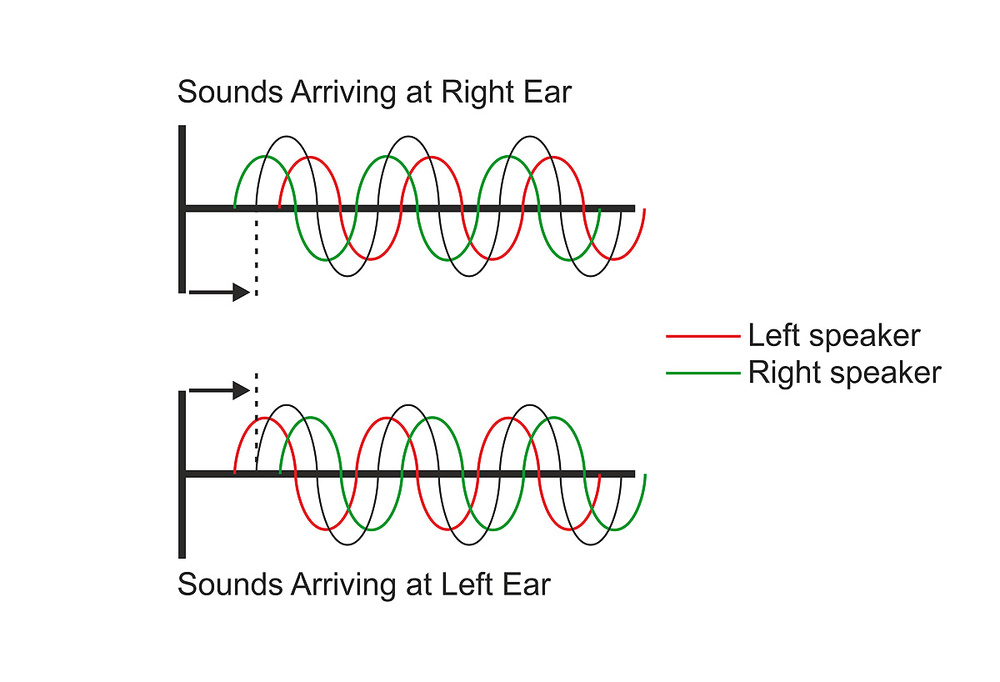
Broken Stereo?
Blumlein’s concept of stereo sound produced by two spaced loudspeakers relies on the notion that both speakers reproduce the same sound at the same time, and that the wave-fronts they produce differ only in amplitude, not phase. This ‘intensity stereo’ concept was detailed in a patent filed in December 1931 and granted to Blumlein in June, 1933.
A fundamental part of this system is that both of the listener’s ears hear the outputs of both speakers and — critically — the differing path lengths between a speaker and each ear introduces small time delays (see diagram).
 Consequently, each ear receives two sound waves that differ in amplitude (because of the intensity-encoded stereo imaging information), but also in phase because of the relative time delay from the far speaker. These two sound waves combine at the ear, where the net effect of their differing amplitudes is to alter the perceived arrival time of the composite wave-front at one ear relative to the other thus broadly replicating the way our hearing mechanism detects the spatial positions of sound sources in real life.
Consequently, each ear receives two sound waves that differ in amplitude (because of the intensity-encoded stereo imaging information), but also in phase because of the relative time delay from the far speaker. These two sound waves combine at the ear, where the net effect of their differing amplitudes is to alter the perceived arrival time of the composite wave-front at one ear relative to the other thus broadly replicating the way our hearing mechanism detects the spatial positions of sound sources in real life.
In many ways it’s remarkable that this scheme works as well as it does, but in reality most of us find this illusion of spatial sound positioning quite convincing and reliable. However, there is a fundamental problem associated with this system, and it was described in a 1958 paper presented to the Audio Engineering Society (AES) by three EMI engineers, Clark, Dutton, and Vanderlyn (all former colleagues of Blumlein’s, continuing his work after the war). Their argument was that this two-speaker arrangement only works accurately for frequencies below about 700Hz. Above that frequency the listener’s head starts to act as a baffle between the ears, attenuating the signal from the distant speaker to the far ear. This results in the amplitude differences between channels becoming exaggerated at higher frequencies, and so a form of frequency-dependent spatial smearing exists.
Putting this effect into visual terms, it’s a bit like the chromatic aberration associated with low-quality camera lenses, where red light and blue light refract differently through the lens, so that crisp edges acquire a red tinge on one side and a blue tinge on the other. In effect, the red part of the image is offset from the blue part, reducing the sharpness of the overall picture. A similar effect happens with stereo loudspeaker setups, and the high-frequency elements are reproduced with a slightly wider image than the low-frequency elements, reducing the overall precision and focus of the stereo image.
EMI’s experiments confirmed that the perceived spatial positions of frequency components above and below 700Hz were significantly different, and a corrective filter was designed that transcoded the stereo signal into the Mid-Sides format, reduced the Sides level above 700Hz by 3dB, and then transcoded back to left-right. This filter was called the Stereosonic Shuffler and it was built into EMI’s in-house REDD mixing consoles employed throughout the ’50s and ’60s.
Inevitably, the required circuitry was relatively complex and expensive, and unfortunately it introduced undesirable distortions and colorations because of inaccuracies in the necessary phase-correction elements. As a result, many at EMI thought the improvement in imaging precision was outweighed by the tonal compromises, and Stereosonic Shuffling fell out of favour: uncorrected stereo was deemed ‘good enough’ for the end consumer.
Interestingly, though, it probably was! In the days when the primary consumer medium was vinyl records, the inherent mechanical and electrical crosstalk introduced by the pick-up cartridges at high-frequencies acted to reduce the HF image width — in effect, imposing Stereosonic Shuffling automatically. Perhaps the resulting sharper imaging is one reason why many still claim the superiority of vinyl!
Since this HF crosstalk has been meticulously engineered out of the CD and other digital formats — as well as analogue studio master tape recordings — some form of image width correction remains desirable for these replay formats.

